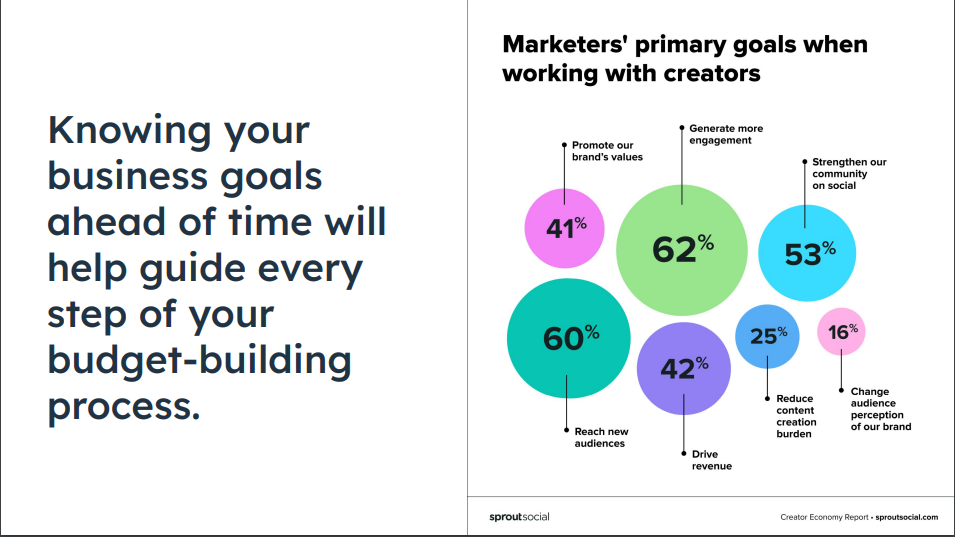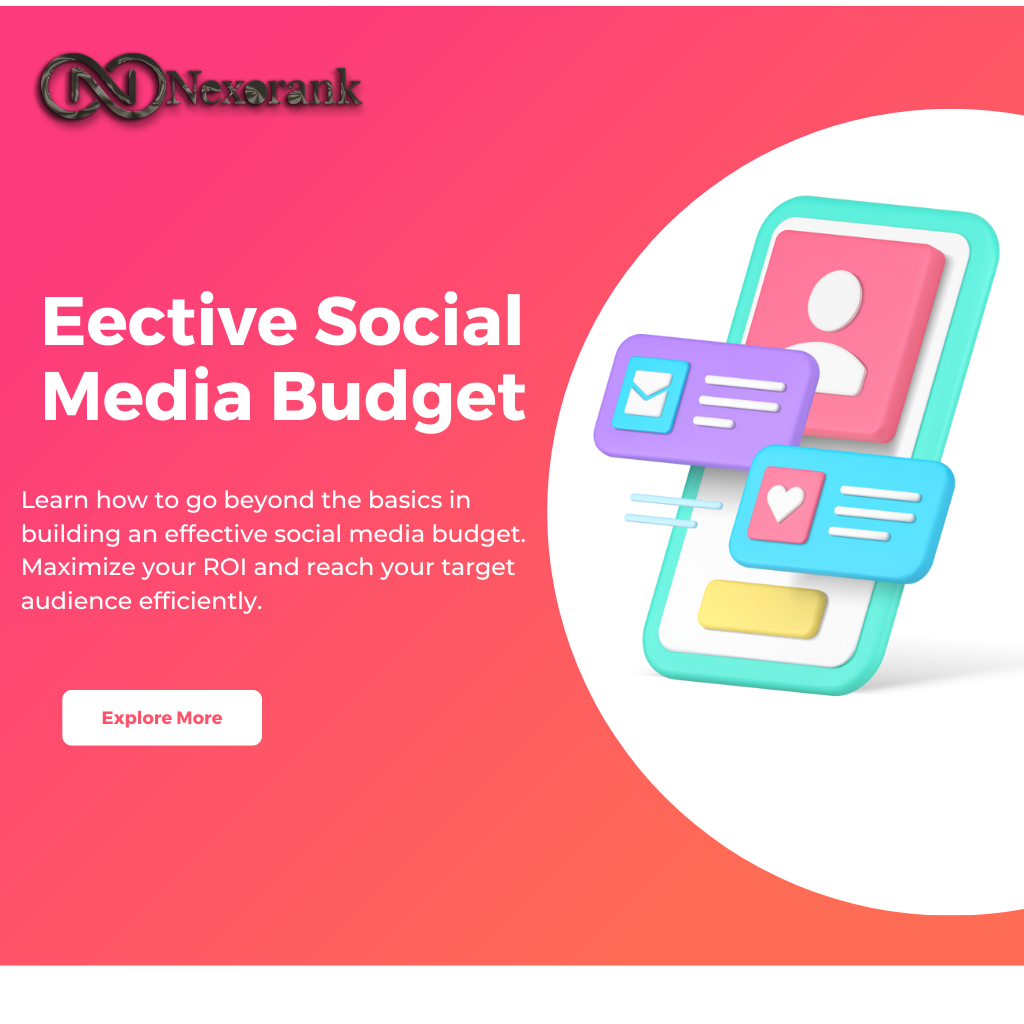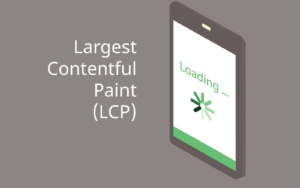Creating a social media budget is an important first step for any business looking to establish or improve its online presence. With so many platforms and options available, it can be dicult to know where to start and how much to invest. However, by setting a budget and allocating funds strategically, businesses can ensure they’re getting the most out of their social media eorts.
Whether you’re a small business just starting out or a larger organization looking to expand your online reach, a well-crafted social media budget can help you achieve your goals and drive real results.
Before you begin the budgeting process, make sure you’ve mapped your business goals and have an idea of how social media might be able to help you reach them. Sprout Social developed this infographic which demonstrates how marketers are thinking about their business goals when they’re working with creators. As you can see, knowing your business goals ahead of time will help guide every step of your budget-building process.
For example, if you’re looking to drive customer engagement, you may want to spend more on developing a social media community or on hiring people to answer questions and engage with followers. But if you’re looking for brand recognition, you might want to put more money into attention-grabbing social media ads. Before you begin budgeting, you need to know what platforms and tools you intend to use. If you’re still building that out, you may want to consider giving yourself some room in the budget to help you do some testing — this may help you know what sort of resources you’ll ultimately need to budget for.
Here’s Andrew Worob, Sr. AD, Corp Digital Strategy, and Corp Brand Touchpoints, Boehringer Ingelheim, and board member at Socialmedia.org to share more:
Andrew Worob: So when it comes to companies determining when to start using new tools, new platforms, it almost always depends. You need to take into account whether or not your audience is on these new channels., what the short term and long term goals are of your company, and at the end of the day, do you even have the resources to extend yourself into another platform? Are you already at a place where you’re doing well and have maximized? And have you scaled some of the activities that you’re already doing that allows you to, perhaps, test a di erent platform? I’m always of the belief that testing and learning is critical to success. And so, if a platform makes sense for your brand and your audience is there, it’s a healthy approach to try something new. I just would be careful about over indexing in it, because oftentimes, when there are new tools, new channels, new trends out there, you sort of need to dip your toes in the water first, and figure out what’s working and what’s not. So as long as you have the bandwidth to test something out new, and it makes sense for your brand, then absolutely go there and test and learn, and don’t be afraid to fail.

Having a benchmark to work with is also helpful. According to CMO Survey , the percentage of marketing budget businesses will spend on social media in a year breaks down as follows:
● B2B Product: 14.7%
● B2B Services: 18.3%
● B2C Product: 21.8%
● B2C Services: 18.7%
Social media spend also varies by sector:
- Consumer services: 28.5%
- Communications and media: 25.6%
- Banking and finance: 11.7%
If you need a monetary benchmark, The Content Factory determined that the average organization spends between US $200 and $350 per day on social media marketing or about $6,000 to $10,500 per month.
Now, what expenses should you include in your budget? Let’s start with the people you’ll need.

What content creators do you need to write and film creative and engaging content?
Can you develop content in-house or will you need to hire an agency?
- If you have a global program, will you need translation services?
- Do you need video editors or graphic designers?
- Do you have the right customer care resources to respond to customer comments, problems, or questions?
- Do you need training for your social media team?
Knowing who will be involved in your social media e orts will help you determine whether you need to allocate a budget toward hiring copywriters, editors, freelancers, or social media agencies to help you meet your goals.
When considering agency services, keep in mind that you sometimes get what you pay for. Make sure you adequately vet the agencies to determine which ones will drive the best results for your organization within your budget range. To find out more about choosing a social media agency, check out the resources section .
If you’re still building your social media team and need some tips, check out the video, Structuring Your Social Media Team for Now & The Future , from our beginner level social media certification. You can also find that link in the resources section.
Next, you’ll need to think about content creation and production. Your budget will a ect the type of content you can create — whether it’s scrappy and casual videos created on an iPhone, or videos created with full studio production. Keep in mind that average video production costs in the United States, for example, can run between $880-1,200.
Here are some technology costs you should also consider including in your budget:
- Camera and/or video equipment
- Lighting and recording equipment
- Stock photography and images (e.g. Getty Images)
- Design and editing software (e.g. Canva, Adobe)
- Social media monitoring and publishing tools (e.g. HubSpot)
- Analytics tools (e.g. Talkwalker, RivalIQ)
Another cost to consider is the talent you want to include in your posts and videos. Hiring acelebrity or micro influencer can make a big di erence for your content’s reach and engagement, but it’s important to remember that they both cost money. And of course, working with a celebrity will cost more.
Sprout Social’s Creator Economy Report outlined some of the average creator compensation rates for various types of content in this handy infographic. For example, a story post may cost a lot less to create than a dedicated video featuring a creator.
And finally, you’ll want to set aside a portion of your social media budget for advertising. There are a few tips to keep in mind:
1. Determine which social networks will best reach your ideal buyer. If you don’t know who your ideal buyer is, check out the resources section for a link to the free HubSpot Make My Persona tool .
2. Set trackable goals that map to your business goals. This will help you determine what types of ads you’ll run.
3. Don’t run the same ad across each platform. Make sure you tailor your ads to the audience. For example, you may determine that you’ll run video ads on Instagram but lead ads on LinkedIn. This requires two di erent kinds of content, and you’ll need to budget for the creation of both.
4. Start small and run A/B tests. In some cases, you can start running ads on a platform for as little as a US dollar per day. If you determine that one type of ad or one platform performs better than another, you can shift and increase your spend in the more successful ad. For more details, check out the link in the resources section to the lesson, Introduction to Social Media Advertising from the Social Media Certification I.
Andrew Worob: So companies in general should be testing di erent formats when it
comes to trying to get their audience’s attention — whether that’s a 15 second video, a minute-long video, or something more than that. Rely on some of the data to help keep you informed as to what’s working and what’s not. It’s often really challenging to tell a story in a 15 second format. But if audiences are responding to that, if they’re taking the actions that you want them to take, then that’s something that you should absolutely lean into. But when it comes to social media, you never want to lean into something 100%. If something is working, double down on it, but continue to test di erent things. If a 10 second video works great, what happens when you extend it to 15 seconds to 30 seconds? Really try to understand that audience behavior to help dictate and inform what your social media strategy should be.
How much of your budget you should put into social ads depends on your overall goals. If you’re looking to build engagement and improve customer service online, ads might not be the best avenue. But if you’re looking to build brand awareness, you might consider allocating a larger percentage of your social media budget toward ads.
Digital marketing agency, Web Strategies , reminds us that you need to think about your advertising holistically, not just what will go toward the ad spend itself. Here’s a rough estimate of the activities and allocation percentages to include in your budget when developing your ads:
- Strategy: 10%
- Project Management: 5%
- Design, Graphics, Videography, Visuals: 30% Ad Spend: 40%
- Copywriting: 10%
- Tracking Results: 5%
And of course, you’ll need to track and measure the results of your e orts so you can determine if you can reap a return on your investment, or ROI.
Evaluating Social Media ROI and Budget Planning
Andrew Worob: So when evaluating ROI for social media, Ithink it’s critical to first identify why you’re there to begin with. In other words, are you active on a channel, and you’re there because your audience is there? What is that reason ultimately behind why you’re doing what you’re doing? Why do you put a team in place? So once you’re clear on what you’re doing and why you’re doing it, it’s relatively easy to then back into that ROI. And if you have the proper talent in place as well as a support system, both in-house or external, you can often measure anything. But it’s about measuring the right things that are ultimately going to show your business the impact that this e ort is making, be it on
sales, an acquisition, customer service, or whatever the case may be. There’s almost always something you can do to measure that impact.
If you were a student of the first Nexorank Academy Social Media Certification, you may recall a lesson explaining how to measure your social media return on investment (ROI), which can help you know if you need to adjust your budget or set di erent parameters for next year’s budget. If you haven’t seen it, or need a refresher, you can find the link in the resources section .
There’s a lot to think about when it comes to building your social media budget, but I have one last bit of advice for you. When you’re pulling your plans together, think about how you can incorporate experimentation. Test di erent types of content and ads before you decide how to allocate all your spend. Do some testing to determine what works, and then you can put more money toward those activities that will best help you meet your business goals.





















